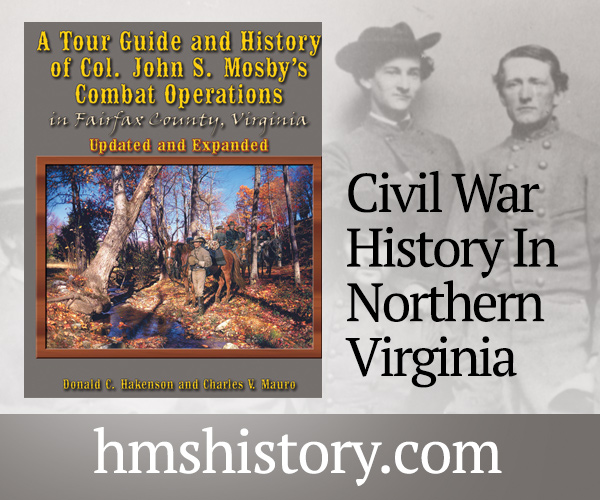By Cliff Krainik
Washington, D.C. – Saturday, September 17, 2022
On a bright, beautifully clear Indian summer afternoon about a hundred invited guests attended the unveiling of the new interactive memorial to Mathew B. Brady in Congressional Cemetery. The memorial was erected on a double plot right next to Brady’s final resting place and features state-of-the-art photography displays. The expansive memorial was the creation and personal contribution of photographic historian Larry West of Washington, D.C. From its inception the site was designed to engage and inform visitors about Brady’s heroic efforts to record the history of his era through the enduring power of photography. West’s tribute to Brady evolved gradually over a period of four years. The central element incorporates a granite wall 8 feet high by 8 feet wide that tells in detail Brady’s life story. On the back side of the wall are two bronze plaques with Brady’s biographical information about his photographic career, his success, financial disasters and his relegated obscurity.
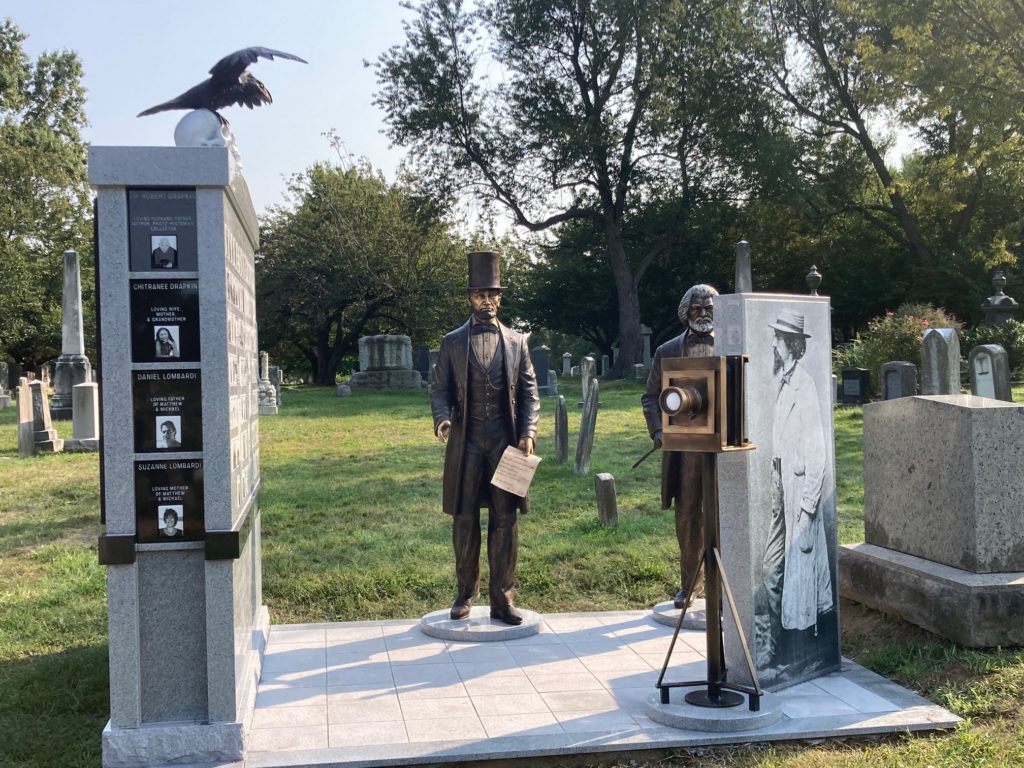
On the front of the wall are positioned eighty-five fired porcelain reproductions of Brady photographs, mostly by Brady and his photographers. A group of fourteen portraits of Brady, his wife Julia and his nephew and business associate, Levin Handy are displayed in one section. Another grouping of a dozen or so images portrays Abraham Lincoln, his assassin, the conspirators and their execution. Twelve images of African Americans grace the Brady display including the likenesses of Sojourner Truth, Harriet Tubman, Frederick Douglass, and William Still, “Chief Conductor” of the Underground Railroad. Of course Brady’s portraits of famous personalities from all walks of life are here too among them Generals Grant and McClellan, First Lady Dolly Madison, writers Walt Whitman, and Charles Dickens, P.T. Barnum and Tom Thumb, Thomas Edison, Oglala Lakota leader Red Cloud, General Custer and “The March King” John Philip Sousa who, incidentally, reposes not very far from the Brady Memorial. To illustrate how many important Brady photographs are of an iconic nature, part of the display presents United States postage stamps with the portraits of famous Americans taken by Brady including presidents Zachary Taylor, Abraham Lincoln, U.S. Grant, Rutherford B. Hayes plus Clara Barton founder of the American Red Cross and the artist and inventor Samuel B. Morse. In a final acknowledgement to Brady’s connection to the U.S. Postal system, Larry West fashioned a section of portraits relating to the Pony Express. Shown are the likenesses of Buffalo Bill Cody who rode the Pony Express at age fifteen, a group of the first riders, Richardson, Fry, C & G. Cliff and a fine likeness of Sophia Hollenberg, co-founder of the Kansas Station– all portraits taken by Brady.
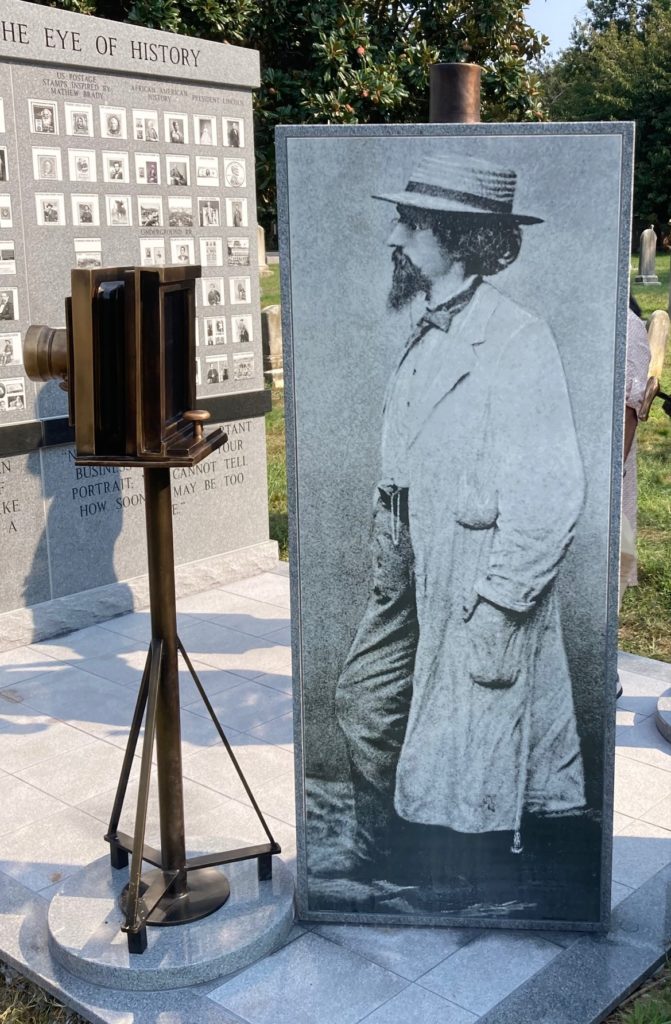
Facing the wall with its multitude of imagery is a state-of-the- art, full-length, life size fired porcelain photograph of Mathew Brady. The original portrait of Brady wearing a duster and straw hat, was taken shortly after his return from the ill-fated sojourn to the battlefield of Bull Run, July 1861. His likeness is position next to a bronze rendering of a large format, circa 1860s wet-plate view camera.
Approaching the Brady and camera ensemble are two life size heroic statues of President Abraham Lincoln and the great American social reformer and statesman Frederick Douglass. Lincoln holds a sheet of paper in hand with a written excerpt from the Emancipation Proclamation – “All persons held as slaves shall be then, thenceforward and forever free. Done at the city of Washington, this first day of January in the year of our Lord one thousand eight hundred and sixty three. By the President Abraham Lincoln” Frederic Douglass, the most photographed man of the 19th century, holds a walking stick given to him by Mary Lincoln after the assassination of the president. The bronze cane is an exact replica copied from the original owned by the National Park service on display at Cedar Hill, Frederick Douglass’s estate in Anacostia. Both statues were cast at the Matthew Foundry near Venice, Italy then shipped to Georgia for assembly before installation at Congressional Cemetery.
Larry West expressed his thoughts about Mathew Brady on two bronze plaques attached to the memorial:
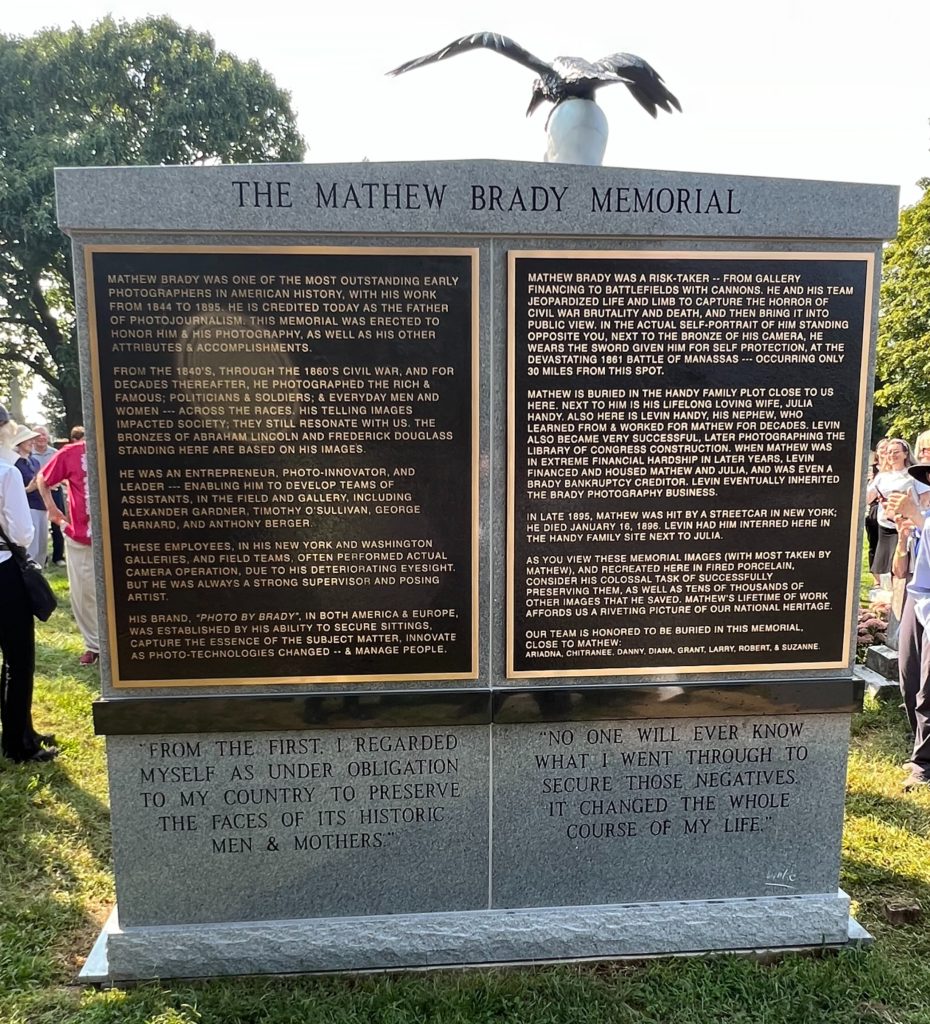
“THE CAMERA IS THE EYE OF HISTORY Mathew Brady was one of the most outstanding early photographers in American history, with his work from 1844 to 1895. He is credited today as the Father of Photojournalism. This memorial was erected to honor him. His photography, as well as his other attributes & accomplishments. From the 1840s, through the 1860s, and for decades thereafter, he photographed the rich and famous; politicians & soldiers; & everyday men and women—across the races. His telling images impacted society; they still resonate with us. The bronzes of Abraham Lincoln and Frederick Douglass standing here are based on his images. He was an entrepreneur, photo-innovator, and leader – enabling him to develop teams of assistants, in the field and gallery, including Alexander Gardner, Timothy O’Sullivan, George Barnard and Anthony Berger. These employees, in his New York and Washington galleries, and field teams, often performed actual camera operation, due to his deteriorating eyesight, but he was always a strong supervisor and posing artist. His brand, “PHOTO BY BRADY”, in both America and Europe, was established by his ability to secure sittings, capture the essence of the subject matter, innovate as photo-technologies changed – & managed people.”
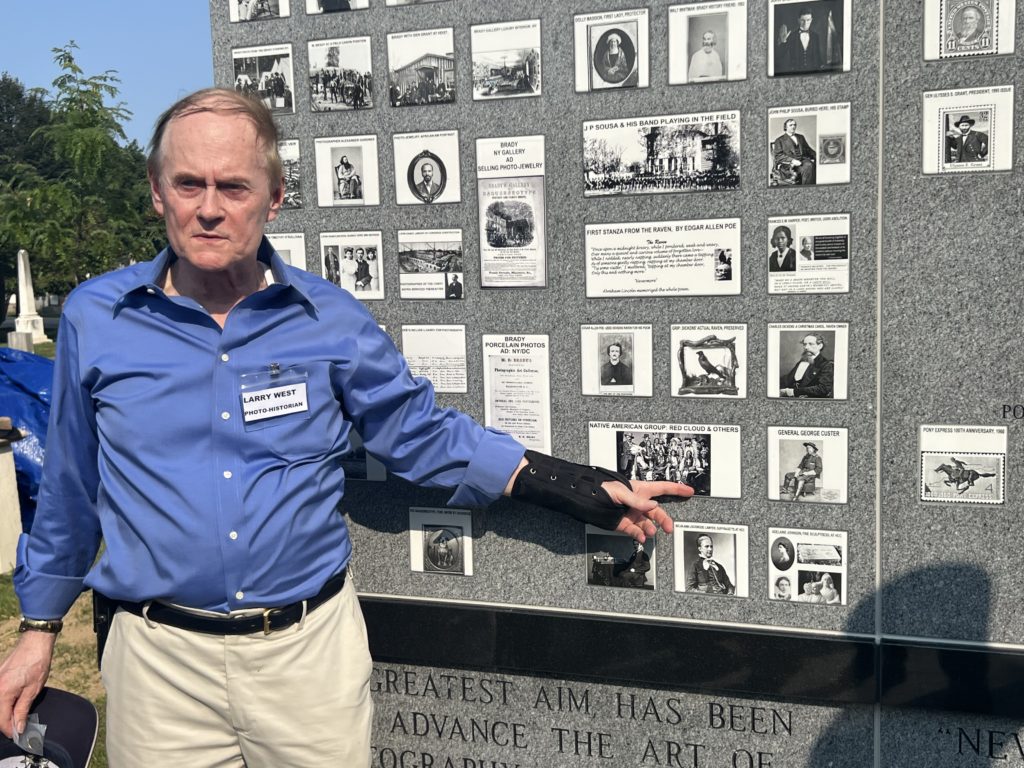
Another plaque is placed on the right side of the columbarium furthest from Brady’s grave. The inscription reads: “Mathew Brady was a risk-taker from gallery financing to battlefields with cannons. He and his team jeopardized life and limb to capture the horror of Civil War brutality and death, and then bring it into public view. In the actual self-portrait of him standing opposite you, next to the bronze of his camera, he wears the sword given him for self-protection, at the devastating 1861 battle of Manassas – occurring only 30 miles from this spot.
Mathew is buried in the Handy family plot close to us here. Next to him is his lifelong loving wife, Julia Handy. Also here is Levin Handy, his nephew, who learned from & worked for Mathew for decades. Levin also became very successful, later photographing the Library of Congress construction. When Mathew was in extreme financial hardship in later year, Levin financed and housed Mathew and Julia, and was even a Brady bankruptcy creditor. Levin eventually inherited the Brady photography business.”

At three in the afternoon as the sun arched westward radiating the acres of stones at Congressional Cemetery, Larry West stepped up to the podium and thanked all for attending. He recounted his lifelong interest in historic photography and spoke about the important collection of antebellum images, mostly daguerreotypes, made by talented African American photographers that he assembled and sold to the Smithsonian American Art Museum. He told about his admiration for the visionary Mathew Brady and how he felt compelled to help educate the current generation of school children about the legacy that Brady had given to them. In turn he introduced the three speakers for the occasion: Cliff Krainik of Warrenton, Virginia, a photographic historian gave a brief account of Brady’s life. He spoke about the visit to Brady’s New York gallery by the Prince of Wales, the future King of England, Edward VII (Queen Elizabeth II great grandfather) and how Brady received a gold ring from the Prince. Cliff related how Brady in 1863 photographed a delegation of Southern Plains Indians who came to visit President Lincoln in the White House. Yellow Bear chief of the Kiowa died a few days after the group photograph and was buried in Congressional Cemetery just a short distance from Brady’s grave. Next, Grant Romer, a world authority on early photography and former Conservator of Photography at the George Eastman House spoke about the lasting quality of photography and how important Brady’s work was in creating an historic memory for the present day; and lastly David Kent, President of the Lincoln Group of the District of Columbia, gave an account of the significant role Mathew Brady’s Cooper Union portrait of candidate Abraham Lincoln played in the election of 1860 and of the several Lincoln portrait sessions in Brady’s Washington gallery during the Civil War.
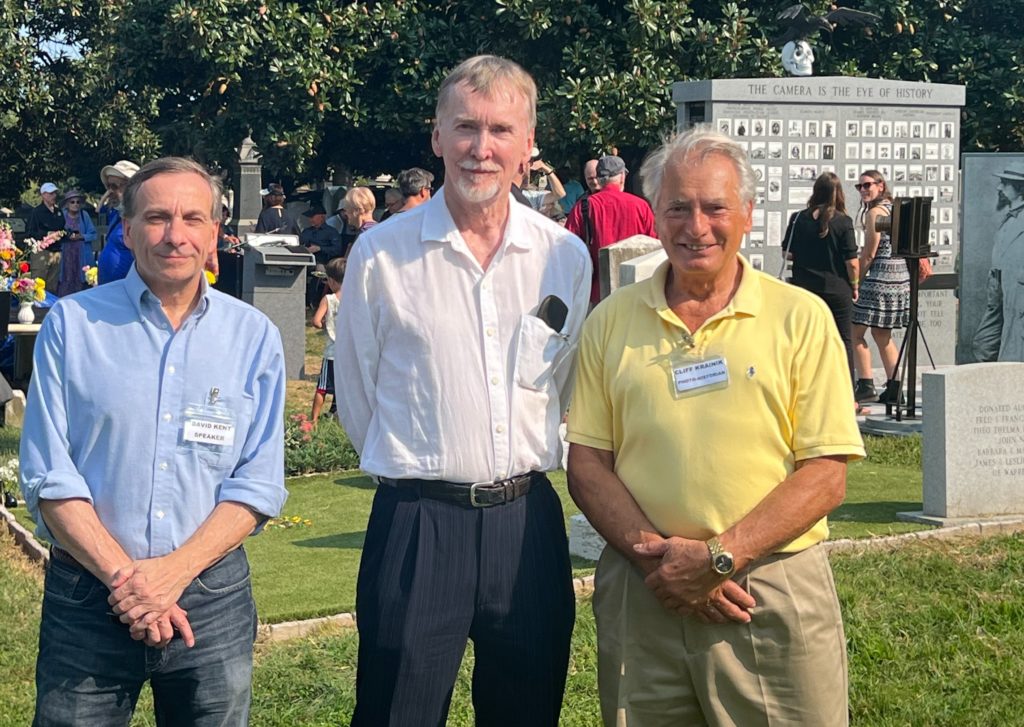
After the presentations were made the congenial group assembled around the memorial and a rollicking toast was offered to the great Civil War photographer – Happy Birthday Mathew Brady ! In the glow of the ebbing afternoon I felt Brady’s presence and imagined him among us directing his assistants where best to position their cameras to record the event. “See over there” whispered Brady –“ That grave stone is the prefect height. Please have Mr. West sit there – I’ll tell you how to take his portrait.”
Learn more about the memorial: “The Camera Is the Eye of History”: A new memorial in Washington, D.C., honors Mathew Brady
Official site: Historic Congressional Cemetery




























